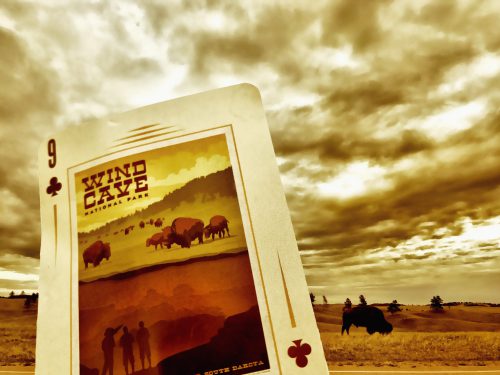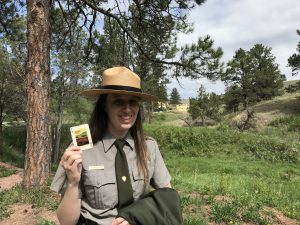
Wind Cave National Park
South Dakota
Wind Cave
Further southwest of the Badlands lies Wind Cave, another appropriately titled National Park. The entire day was full of wind. Blustery gusts blew the rig about as I made the drive on relatively empty roads. A few hours later, I was cruising into the rolling buffalo-strewn landscape of the park. Everything about the place seemed…asleep. I self-registered and had an entire park loop to myself at Elk Mountain campground. During the afternoon, two other vehicles entered the park and lay claim to the other two loops covering a half square mile valley. Now nestled beneath Ponderosa Pines, I realized there was no electricity, services or signal and the only sound that could be heard was the wind whispering in the distance like a living breath. I have since learned that the park closed for a period of years due to lack of use, support and funding. Since reopening, it is still rarely difficult to procure a spot near this eerily tranquil National Monument. Wind Cave’s history is not as serene, however, it is full of ancient mythology, family feuds and more government dominance.
The cave was designated a park by the Department of the Interior years before the National Park Service even existed. The government had seized the land from two feuding families who had capitalized on tours of the attraction in the late 1800s and later disputed one another’s homestead and mining claims. The Fed denounced any rightful claim of either party and removed it from the homesteading program. In 1903, Roosevelt officially designated Wind Cave the 8th National Park according to the NPS (Wikipedia claims 7th) and the first park of its kind in the world designed to protect a cave. It holds around 90% of the worlds known Calcite Boxwork and not unlike the surrounding landscape, the densest and 6th longest cave system in the world, breathes in a physical reaction to the barometric pressure of the outside environment. The result yields a meteorological predictive survival technique: Hold a piece of lightweight material in front of an access-way and watch the direction of movement. On clear and sunny days, air is pushed into the cave creating suction and the opposite occurs on rainy, low pressure days in which airflow is pushed out of the cave. Wind Cave moves massive air volumes along its corridors contrasted with other cave systems and due to the smaller access tunnels, can create a forceful airflow through the tiny openings that expose the cave to the outside environment. The subsequent effect of the resulting barometric breathing led the Lakota to treat the area as sacred ground and mythologized it as the entrance way of their ancestors from the underworld and are not known to have ventured into the depths. The homesteaders, attributed with the caves rediscovery by locating one of these gusting holes, found the phenomenon more a novelty that ultimately tapped into cave as well as the potential market of curious tourists and began the path leading to the National Park of today.
123 miles have been charted to date and exploration continues. It is speculated the system may even connect with the not too distant Jewell Cave, currently the World’s 3rd largest known system. Even in combination, both caves would hardly close the gap with the World’s longest system, Mammoth Cave, in Kentucky (400 miles and growing). Since I have ventured more than three miles underground in unguided wild cave exploration, I almost passed up the short, guided tour through a brief section of the cave. It didn’t take long to realize the likelihood of me ever being here again was nil and that I had better seize the opportunity while I could. Besides, I was still hoping to capture a shot with another card from the Anderson Design Group NP Collection while I was there. I was glad I did. Besides I was helping to sustain the park by staying on premises and paying for the tour. NPS Ranger, Meredith Peterson, guided our small group of 20 through the brief section of cave and was both knowledgeable about the cave and clearly passionate about her connection to the place. She was kind enough to strike a pose with the 2 of Spades in a shout out to Wind Cave National Park and Anderson Design Group.

After the tour, I communed with the indigenous. Several buffalo and a small herd of prairie dogs kept close company as I munched on a breakfast snack. I took in scene and lost myself for a a moment until a few thousand pounds of lumbering Tatonka brushed against the truck jerking me back into reality. It was a bit surreal and I ended up with some pretty entertaining video footage I hope to compile when I Happen to find some spare time. And then, like the wind, I was off again. Destination, Casper, Wyoming, to catch up with an old brother in arms and Wind Cave was bid a fond farewell.
Ruckin on…
